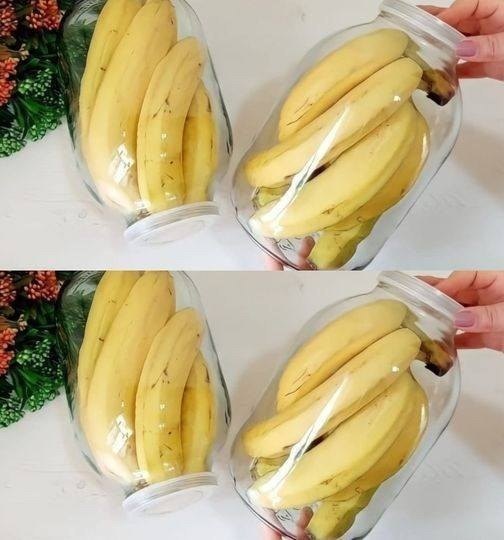Bananas are one of the most popular and widely consumed fruits globally. Known for their natural sweetness and versatility, they are often consumed fresh, added to smoothies, baked goods, or eaten as a quick snack. However, the life span of bananas is notoriously short. A few days after purchase, they often start to ripen and turn black, sometimes leading to waste, especially if they aren’t eaten in time. But what if there was a way to keep your bananas fresh for an extended period, without the usual concerns of spoilage?
In this article, we’ll explore an innovative method that can prolong the shelf life of bananas for up to two years, and in doing so, significantly reduce food waste and save you money. This simple but effective technique can help preserve bananas in their fresh state for an extended period, making it easier to enjoy this nutritious fruit without the pressure of it spoiling.
The Problem with Bananas: Short Shelf Life
Bananas are climacteric fruits, which means they continue to ripen even after being harvested. Once picked, bananas will undergo various stages of ripening, starting from green to yellow and eventually turning brown and black as the sugars in the fruit become more concentrated. The skin softens, and the fruit’s flesh becomes mushy, making it unsuitable for fresh consumption.
Typically, bananas last only a few days to a week at room temperature. Once they ripen, they begin to degrade quickly, and once the peel turns black, many people throw the fruit away, considering it too far gone to eat. However, bananas that are overripe can still be used in smoothies, baking, and other recipes. The real issue is preventing that rapid decline in freshness.
The Solution: Freezing Bananas for Long-Term Storage
The key to preserving bananas for up to two years is through freezing. Freezing bananas is a simple and highly effective method to preserve them in their best state for months or even years. The process involves slowing down the ripening and spoilage process by storing the fruit at extremely low temperatures, which halts enzymatic activity responsible for ripening. By freezing bananas, you can extend their shelf life for up to two years, while still retaining their taste, texture, and nutritional value.
In the next section, we’ll explain how freezing bananas works, and provide a step-by-step guide on how to freeze them properly to avoid the typical pitfalls of freezer burn and mushy texture upon thawing.
Why Freezing Works
When bananas are frozen, the water content in the fruit turns into ice crystals. This prevents the fruit’s natural enzymes from causing ripening, allowing the bananas to retain their nutritional value. Freezing also maintains the fruit’s shape and structure, though they may soften slightly upon thawing. However, this does not mean they will lose their flavor or nutritional benefits.
The freezing process also helps maintain the high potassium content in bananas, as well as other essential vitamins like vitamin C and B6. When frozen correctly, bananas can be used for various recipes, including smoothies, baking, or even as a frozen treat when sliced and eaten straight from the freezer.
The Step-by-Step Guide to Freezing Bananas for Long-Term Storage
Freezing bananas is simple, but to ensure the best results, it’s important to follow a few simple steps. By doing so, you can ensure that your frozen bananas last for a long time without losing quality. Here’s how:
1. Choose the Right Bananas
Select bananas that are ripe but not overly ripe. Ideally, they should still have a yellow peel with a few spots, indicating that they’re at their peak of ripeness. Overripe bananas can be frozen too, but they may not be as ideal for slicing or using in certain recipes, as they become mushier once thawed.
2. Peel the Bananas
Peel the bananas before freezing them. This is an important step because the peel can become difficult to remove after freezing, and it also tends to darken. Peeling them in advance saves you the hassle later and ensures you’re left with the soft, edible fruit only.
3. Slice or Keep Whole (Based on Your Needs)
At this point, you can choose how to freeze the bananas:
- For Slices: Cut the bananas into slices or chunks if you plan to use them in smoothies or for baking. Slices also freeze more quickly and evenly, which helps prevent freezer burn.
- For Whole Bananas: If you prefer to freeze the bananas whole, that’s perfectly fine, though they will take a bit longer to freeze. Whole bananas are ideal if you plan on using them in baking or mashed recipes.
4. Arrange the Bananas on a Baking Sheet
Place the peeled banana slices or whole bananas on a baking sheet in a single layer, ensuring that none of the pieces are touching. This will help prevent the pieces from sticking together as they freeze, which makes it easier to take out only the amount you need later.
Click page 2 to continue
5. Flash Freeze the Bananas
Put the baking sheet in the freezer for about 2-3 hours. This quick freezing process helps to solidify the bananas without them becoming mushy or clumped together. Once frozen, you’ll have individual banana pieces that can be stored easily in bags or containers.
6. Transfer to an Airtight Container or Freezer Bag
Once the bananas are fully frozen, transfer them into an airtight freezer bag or container. Be sure to remove as much air as possible from the bag to prevent freezer burn. If using a container, ensure it’s tightly sealed. Label the bag or container with the date of freezing so you can keep track of how long they’ve been stored.
7. Store and Use
Your bananas can now be stored in the freezer for up to two years. For best quality, it’s recommended to use them within a year. When you’re ready to use them, simply remove the desired amount of banana slices or whole bananas from the freezer, and let them thaw at room temperature for a few minutes or use them directly in smoothies or baked goods.
Tips for Optimal Results When Freezing Bananas
While freezing bananas is straightforward, here are a few tips to ensure that they come out of the freezer in the best possible condition:
- Use Fresh Bananas: Only freeze bananas that are at their peak ripeness, as overripe bananas can become mushy after thawing.
- Avoid Overripe Bananas: If bananas are too far gone, they can still be used for baking, but they may not freeze well, as the texture can degrade further.
- Freezing in Small Portions: Freeze bananas in smaller portions to prevent them from sticking together in a large chunk. This way, you can remove just the amount you need, without defrosting the entire batch.
- Use Proper Storage Containers: For long-term storage, it’s best to use heavy-duty freezer bags or vacuum-seal containers to prevent freezer burn.
Additional Storage Methods: Drying Bananas for Long-Term Preservation
While freezing is an excellent method for preserving bananas, there’s another technique worth considering: drying. Dried bananas, also known as banana chips, are another way to preserve bananas for long-term use, especially if you don’t want to use your freezer space.
How to Dry Bananas:
- Peel and slice bananas into thin rounds or lengthwise slices.
- Use a dehydrator or an oven on a low temperature setting (about 135°F or 57°C) to dry the bananas.
- Store the dried bananas in an airtight container in a cool, dry place.
While dried bananas may not have the same texture as fresh bananas, they still provide a sweet and nutritious snack or ingredient for various recipes.
Why Bananas Are a Smart Fruit to Preserve
Bananas are a great fruit to preserve for several reasons:
- Nutritional Value: Bananas are rich in potassium, fiber, and vitamins like C and B6. Freezing or drying them doesn’t diminish these nutrients.
- Cost Savings: By preserving bananas at their peak, you can save money by buying in bulk and reducing food waste.
- Convenience: Having frozen bananas on hand makes it easier to add them to smoothies, baking recipes, and even quick breakfast bowls.
- Reduction in Food Waste: Freezing bananas helps cut down on the amount of fruit that goes to waste, helping the environment by reducing unnecessary landfill waste.
Conclusion: Say Goodbye to Rotten Bananas
Thanks to freezing, the problem of rotten and black bananas can be a thing of the past. By preserving bananas in the freezer, you can enjoy this sweet, nutritious fruit for up to two years without worrying about spoilage. Whether you prefer to freeze banana slices for smoothies or whole bananas for baking, the method is simple and effective. Not only will you save money and reduce food waste, but you’ll always have a supply of bananas ready to use in your favorite recipes. So, next time you buy bananas, don’t let them go to waste—freeze them and enjoy the fruit of your labor for months to come!




